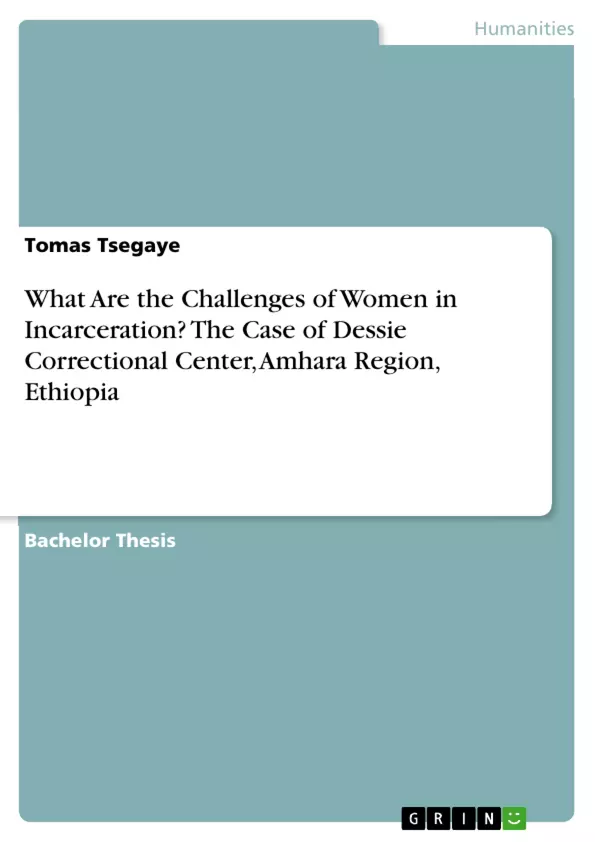Women constitute a vulnerable group in prisons due to their gender. They face unique challenges compared to their male counterparts. These challenges include: a high level of mental healthcare needs, domestic violence and sexual abuse against women in prison. Therefore, the main objective of this study is to assess the challenges female inmates face in Dessie correctional center in South Wollo zone, Amhara region, Ethiopia.
To conduct this study, mixed research approach employed. The sources of data were primary; questionnaire, key informant interview and focus group discussion and secondary sources; published and unpublished materials. To accomplish the study, all women inmates were selected as sample of the study by using comprehensive sampling and key informants were selected by using purposive judgmental sampling. The obtained data was analyzed and interpreted both quantitatively and qualitatively.
The study finding disclosed that, the number of women prisoners is increasing from time to time within the institution, The study further shows that, lack of sufficient special diet, sleeping materials, health care, food and other services of children in the correctional center. The study shows that children’s are socialized deviant behavior and it has negative effect on their future life. Furthermore, the study reveals that women inmates faced problems related to the working rules of the institution.
In conclusion, the study recommends that the government should aware the society about crime, health service in the institution should be improved by qualified health professionals, the correction administration has to be made more sensitive and responsive to the problems of the children of imprisoned mothers and the working rules of the institution should be improved based on the special needs of female inmates.
Table of Contents
- Acknowledgements
- Table of Contents
- Chapter One: Introduction
- 1.1. Background of the Study
- 1.2. Statement of the Problem
- 1.3. Objectives of the Study
- 1.3.1. General Objective
- 1.3.2. Specific Objectives
- 1.4. Significance of the Study
- 1.5. Scope of the Study
- 1.6. Limitations of the Study
- 1.7. Challenges in Conducting the Study
- 1.8. Operational Definitions
- 1.9. Organization of the Paper
- Chapter Two: Review of Literature
- 2.1. Basic Concepts
- 2.1.1. Correctional Institution
- 2.1.2. Prison
- 2.1.3. Female Inmate
- 2.1.4. Vocational and Educational Programs
- 2.2. Issues Women Inmates Face in Correctional Center
- 2.2.1. Sexual Abuse
- 2.2.2. Physical and Mental Health Care of Women Inmates
- 2.2.3. Pregnancy
- 2.3. The Situation of Children inside Prison
- 2.4. Correctional Institution Policies
- 2.4.1. Policies Regarding Health Treatment in Prison
- 2.4.2. The Interaction between Male Inmates and Female Inmates
- 2.4.3. Gender Responsive Correctional System for Women Prisoners
- 2.5. Theoretical Frame Work about Women Criminality
- 2.5.1. General Strain Theory
- 2.5.2. Goffman's “total institutions”
- 2.5.3. Feminist Theory
- 2.6. Conceptual Framework
- 2.1. Basic Concepts
- Chapter Three: Research Method
- 3.1. Description of Study Area
- 3.2. Study Design
- 3.3. Research Approach
- 3.4. Sources of Data
- 3.4.1. Primary Source of Data
- 3.4.2. Secondary Sources of Data
- 3.5. Methods of Data Collection and Instruments
- 3.5.1. Survey
- 3.5.2. Key Informant Interview (KII)
- 3.5. 3. Focus Group Discussion (FGD)
- 3.6. Study Population and Sampling Design
- 3.7. Procedures of Data Collection
- 3.8. Method of Data Analysis
- 3.9. Plans for Data Quality Assurance
- 3.10. Ethical Considerations
- Chapter Four: Result and Discussion
- 4.1. Background Characteristics of Respondents
- 4.2. Trends and Existing Situations of Woman Inmates in Correctional Center
- 4.3. Health Care Challenges that Women Faced in the Correctional Center
- 4.4. Effects of Imprisonment of Mother on the Children in the Correctional Center
- 4.5. Institutional Challenges and Treatments for women Inmates
- 4.6. Discussion
- Chapter Five: Conclusion and Recommendation
- 5.1 Conclusion
Objectives and Key Themes
This study aims to understand the challenges faced by women in incarceration at Dessie Correctional Center in Ethiopia, focusing on the context of their imprisonment and the specific challenges they encounter within the institution.
- Challenges of incarceration for women
- Health and mental health care of women inmates
- Impact of imprisonment on children of incarcerated mothers
- Institutional policies and their impact on women prisoners
- The need for a gender-responsive correctional system
Chapter Summaries
Chapter One provides an introduction to the study, outlining its background, objectives, and significance. It also discusses the limitations and challenges of the research and defines key terms. Chapter Two reviews relevant literature on the topic of women in incarceration, covering concepts like correctional institutions, female inmates, and the specific issues they face. This chapter explores theoretical frameworks that address women's criminality, including general strain theory, Goffman's "total institutions", and feminist theory. Chapter Three details the research methodology employed in the study. It describes the study area, design, approach, and data sources, outlining the methods used to collect data, including surveys, key informant interviews, and focus group discussions. It also discusses sampling design, data analysis, and ethical considerations. Chapter Four presents the findings of the study and discusses the challenges faced by women inmates at Dessie Correctional Center, focusing on their health care needs, the impact of their imprisonment on their children, and the institutional challenges and treatments they encounter. Chapter Five presents the conclusions drawn from the study, highlighting the key insights and recommendations for addressing the challenges faced by women in incarceration.
Keywords
This research paper focuses on the challenges of women in incarceration, particularly within the context of Dessie Correctional Center in Ethiopia. It examines topics such as female inmates, correctional institutions, health care access, gender-responsive correctional systems, and the impact of incarceration on children. The study utilizes theoretical frameworks like general strain theory, Goffman's "total institutions," and feminist theory to interpret findings and inform recommendations for improving conditions for women in prison.
- Quote paper
- Tomas Tsegaye (Author), 2018, What Are the Challenges of Women in Incarceration? The Case of Dessie Correctional Center, Amhara Region, Ethiopia, Munich, GRIN Verlag, https://www.grin.com/document/511267



